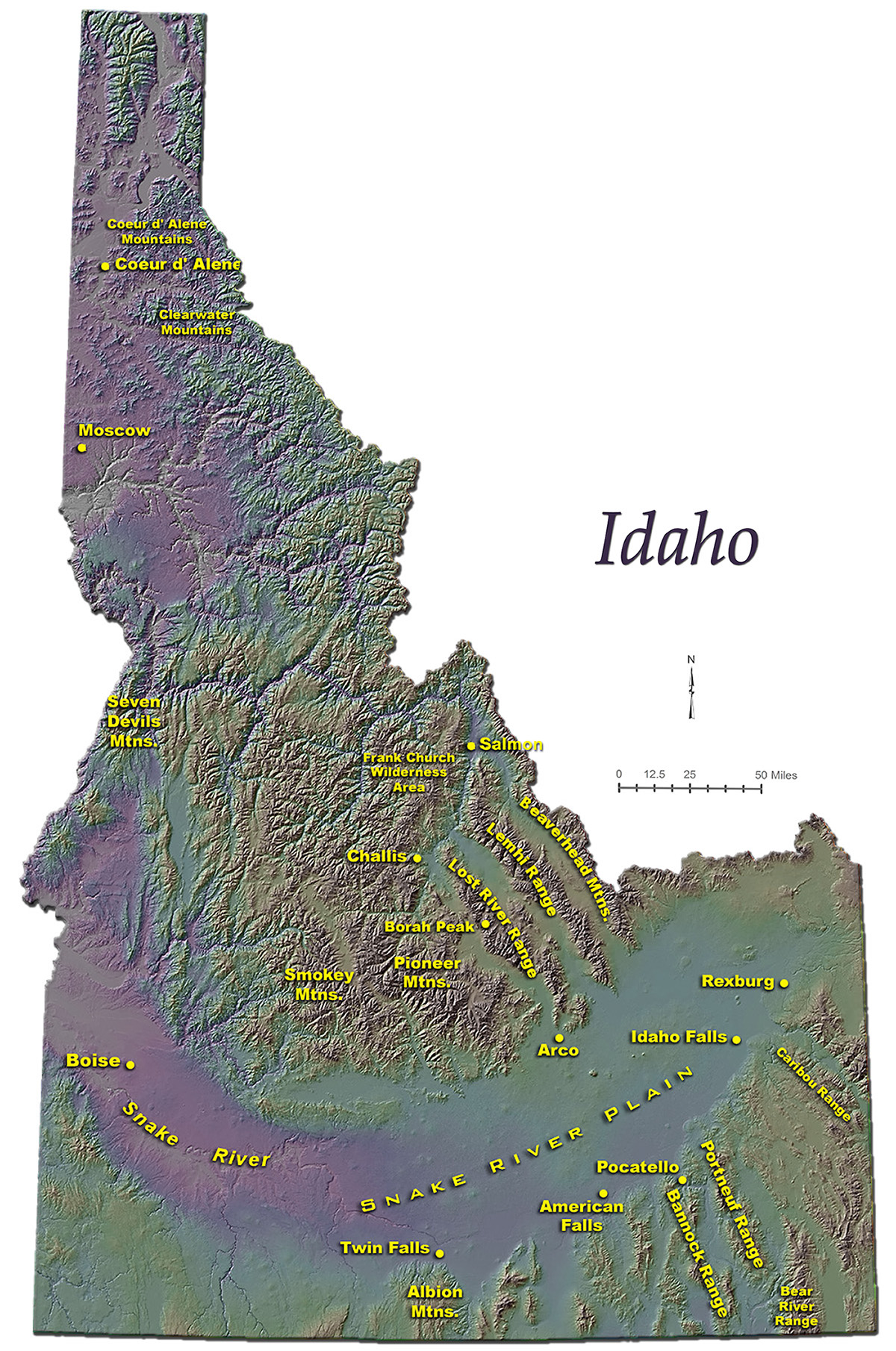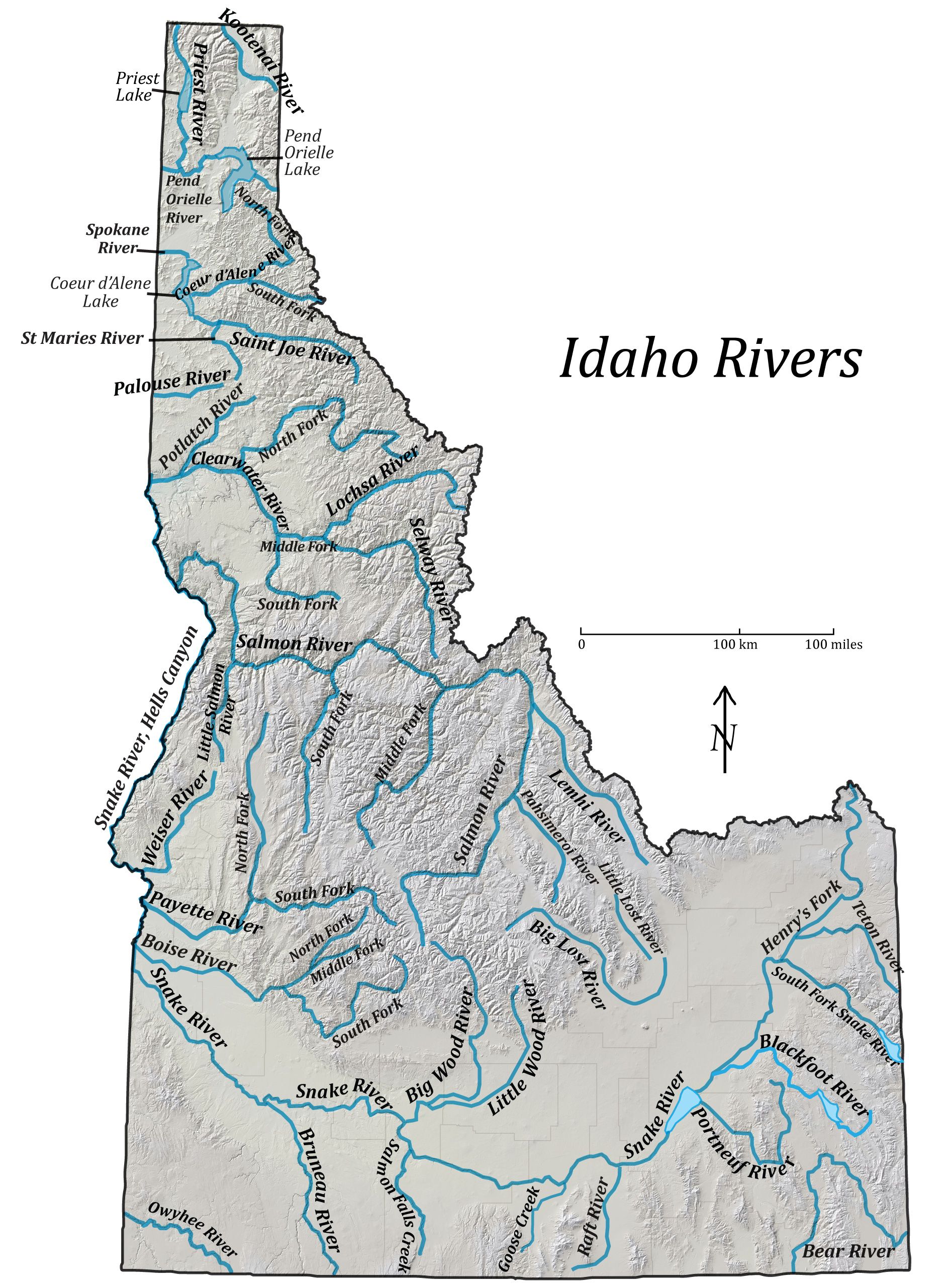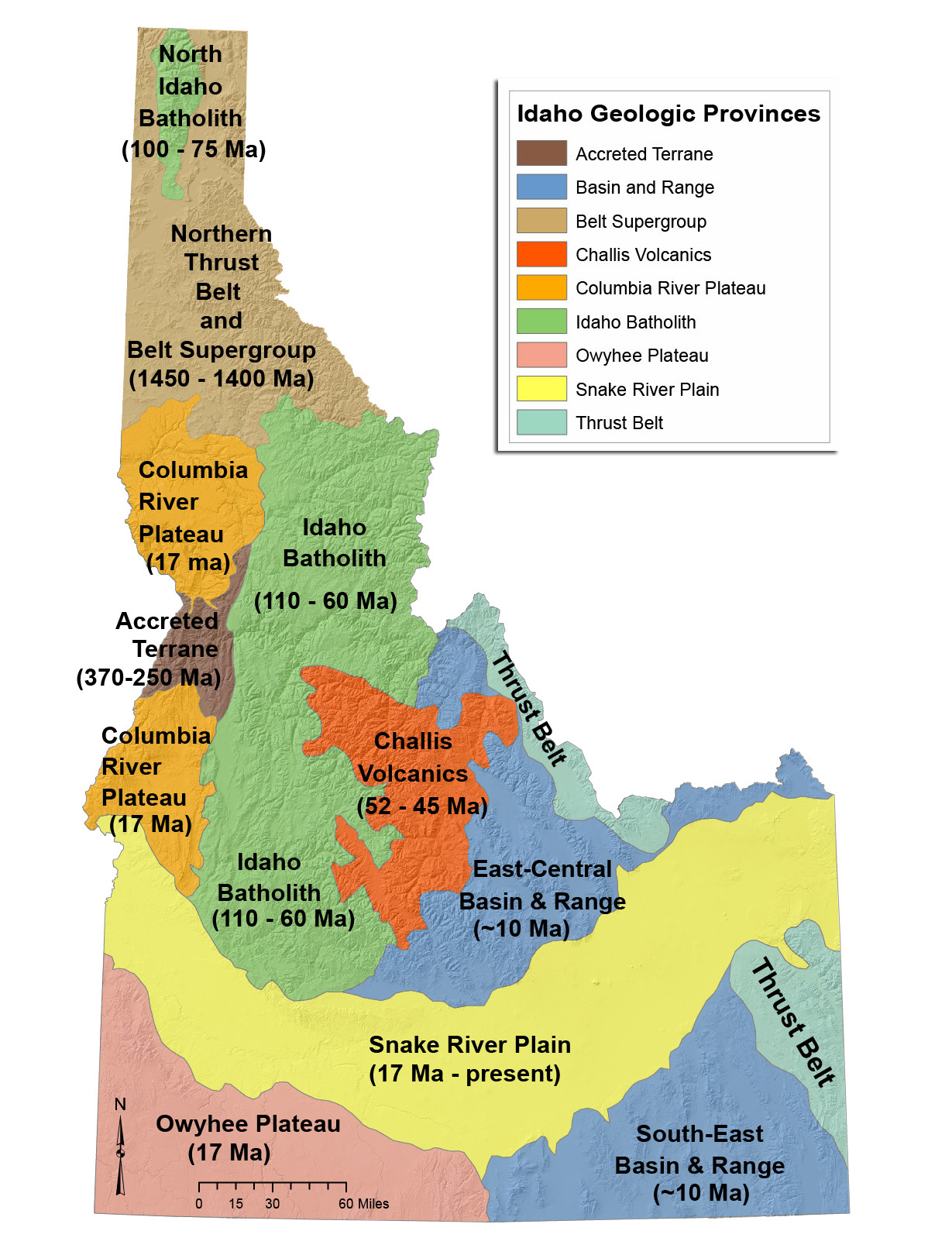
Introduction
Welcome! This site explores Idaho geology through a series of modules that can be used as teaching segments in an undergraduate-level Geosciences class or as a general source of information about Idaho's geology.
The Digital Atlas of Idaho is written at a more accessible level and is a resource that also contains exercises for K-12 teachers.
Geography of Idaho

The state of Idaho is subdivided by its geography. This shaded relief map of Idaho shows the mountain ranges and the major cities.
Idaho rivers

Most of Idaho's rivers drain westward to the Pacific Ocean. Exceptions to this are the Bear River in southeastern Idaho and the Lost River, Birch, Medicine Lodge, Beaver, and Camas Creeks; these drainages never make it to any ocean. More information about Idaho's river systems can be found on the Digital Atlas of Idaho's Drainage Areas & Fisheries page. An unlabeled map of Idaho's rivers can be found here.
Geologic provinces of Idaho

The geologic history of the Earth is recorded in rocks and minerals. Idaho's geologic history spans from >2.6 Ga (giga-annum = billion years ago) to the present. Different parts of Idaho are dominated by geologic features that formed during a particular stage of Idaho's geologic history; here, we call these distinctive regions "geologic provinces."
| Province | Description | Age | Period/Stage |
|---|---|---|---|
| Idaho batholith | The Idaho batholith is a composite mass of felsic plutons covering approximately 35,000 km2. Intrusive igneous rocks: granite, granodiorite, and tonalite. Three lobes separated by geology and geography: Kaniksu Lobe in the Idaho panhandle, Atlanta and Bitterroot lobes in central and north-central Idaho. | 110-53 Ma | Cretaceous and Paleocene |
| Belt Supergroup | Mesoproterozoic sedimentary rocks deposited in a rift basin located in what is now east-central and northern Idaho and western Montana. From bottom to top, consists of Lower Belt, Ravalli Group, Piegan Group, and Missoula Group. These rocks were thrusted and folded during formation of the Sevier-Laramide fold-thrust belt. | 1470-1380 Ma | Mesoproterozoic |
| Sevier-Laramide fold-thrust belt | The Sevier-Laramide fold-thrust belt spans most of the length of North America. In Idaho, it is divided into three segments: the panhandle of northern Idaho to northwestern Montana (the northern thrust belt), from central Idaho to southwestern Montana (the Idaho-Montana fold-thrust belt), and from southeastern Idaho to western Wyoming (the Idaho-Wyoming thrust belt). These parts of the Sevier-Laramide fold- and thrust belt consist of huge sheets of Mesoproterozoic to Mesozoic rock stacked on top of each other along thrust faults as the Earth's crust was shortened horizontally and thickened vertically during Late Jurassic to Paleogene subduction. | 160-55 Ma | Jurassic, Cretaceous, and Paleocene |
| Challis Volcanic Group | Phase of abundant volcanic activity in central Idaho creating intrusive pink granite and eruptions of lavas ranging in composition from rhyolite to andesite. Eruption of Challis Volcanic Group occurred at the same time as northeast-southwest striking normal faults that accommodated crustal collapse after the Sevier-Laramide orogeny. Volcanism was accommodated by formation of major mineral deposits. | 52-45 Ma | Eocene |
| Accreted terranes | Western edge central Idaho. Late Jurassic to middle Cretaceous (160-100 Ma) accretion of "exotic" terranes of Paleozoic limestone on top of oceanic volcanic rock with Jurassic intrusions. | 160-100 Ma | Late Jurassic to Early Cretaceous |
| Columbia River Plateau | Expansive plateau mainly of basaltic volcanic rock located on the western edge of central Idaho. | 17-15 Ma | Miocene |
| Basin and Range | Phase of extension and normal faulting that began about 17 million years ago, forming linear N-S and NW-SE trending mountain ranges in southeastern and east-central Idaho. Extension was superimposed on top of the older thrust belt and formed sedimentary basins consisting of sandstone, conglomerate, and limestone. Cut by the Snake River Plain. Especially during its later phase, extension happened at the same time as Yellowstone volcanic activity. | 17 Ma-Present | Miocene to Holocene |
| Snake River Plain | Belt across southern Idaho consisting of Miocene to Recent volcanic rocks. At most localities, early, explosive eruption of rhyolites was followed by basaltic volcanism. Created by the passage of the North American continent over the Yellowstone "hotspot". | 17 Ma-Present | Miocene to Holocene |
| Owyhee Plateau | A region in southwestern Idaho related to the Snake River Plain but remained a highland region of felsic lava flows and tuffs. | 17 Ma | Miocene |
Continue to Module 1 - Basement rocks of Idaho
Further Reading
Specific research papers and field trip guides are listed under each module. Additional recommended references are below.
Digital Atlas of Idaho: https://digitalatlas.cose.isu.edu
Link, P.K., Willsey, S., and Schmidt, K., 2021, Roadside Geology of Idaho, Mountain Press, Missoula, MT.
Lewis, R., McFaddan, M., Burch, J., and McRaven Feeney, C., 2020, Idaho Rocks!: A Guide to the Geologic Sites in the Gem State, Mountain Press, Missoula, MT.
Orr, W.N., and Orr, E.L., 2019, Geology of the Pacific Northwest, Waveland Press, Long Grove, IL.
Credits and Acknowledgments
This page was moved and updated by Dave Pearson at Idaho State University, made possible by National Science Foundation EAR Tectonics grant 1728563. The original Digital Geology of Idaho website was developed by Paul Link of Idaho State University, Reed Lewis of the Idaho Geological Survey, Shubab Khan of the University of Houston, and Keegan Schmidt of Lewis-Clark State College. Individual webpages were prepared by students of Dan Ames at Idaho State University, with funding from the National Science Foundation grant NSF GEO-0331174. Contributors to content and design were Laura DeGrey-Ellis, Lori Tapanila, Nate Arave, Kristen Straub, Diana Boyack, and many students at Idaho State University.

